[MA-160]
CREATED PEOPLE
When we say the dramatist (and the artist in general) actually creates characters, this is a nice piece of deception and exaggeration in the existence and dissemination of which art celebrates one of its unintentional and as it were superfluous triumphs. In reality we understand very little of an actual living person and generalize very superficially when we attribute to him this or that character: well, the poet adopts the same very imperfect posture towards man as we do, in that his sketches of men are just as superficial as is our knowledge of men. There is much illusion involved in these created characters of the artists; they are in no way living products of nature, but, like painted people, a little too thin, they cannot endure inspection from close to. And if one should even venture to say that the character of the ordinary living man is often self-contradictory and that created by the dramatist the ideal that hovered dimly before the eye of nature, this would be quite wrong. An actual human being is something altogether necessary (even in those so-called contradictions), but we do not always recognize this necessity. The invented human being, the phantasm, desires to signify something necessary, but only in the eyes of those who comprehend even an actual human being only in a crude, unnatural simplification: so that a couple of striking, often repeated characteristics, with a great deal of light on them and a great deal of shadow and twilight around them, suffice to meet all their demands. They are thus quite ready to treat phantasms as actual, necessary human beings because they are accustomed when dealing with actual human beings to take a phantasm, a silhouette, an arbitrary abridgment for the whole.— That the painter and the sculptor, of all people, give expression to the "idea" of the human being is mere fantasizing and sense-deception: one is being tyrannized over by the eye when one says such a thing, since this sees even of the human body only the surface, the skin; the inner body, however, is just as much part of the idea. Plastic art wants to make characters visible on the outside; the art of speech employs the word to the same end, it delineates the character in sounds. Art begins from the natural ignorance of mankind as too his interior (both bodily and as regards character): it does not exist for physicists or philosophers.
